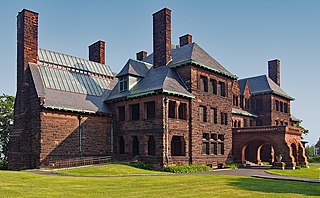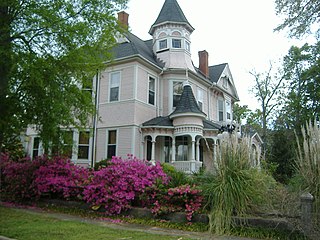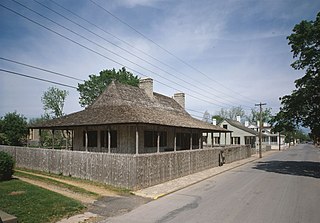
The James J. Hill House in Saint Paul, Minnesota, United States, was built by railroad magnate James J. Hill. The house, completed in 1891, is near the eastern end of Summit Avenue near the Cathedral of Saint Paul. The house, for its time, was very large and was the "showcase of St. Paul" until James J. Hill's death in 1916. It is listed as a U.S. National Historic Landmark, operated by the Minnesota Historical Society. It is also a contributing property to the Historic Hill District.

Melrose is a 15,000 square feet (1,400 m2) mansion, located in Natchez, Mississippi, that is said to reflect "perfection" in its Greek Revival design. The 80-acre (320,000 m2) estate is now part of Natchez National Historical Park and is open to the public by guided tours. The house is furnished for the period just before the Civil War. Melrose was declared a National Historic Landmark in 1974.

The Bost Building, also known as Columbia Hotel, is located on East Eighth Avenue in Homestead, Pennsylvania, United States. Built just before the 1892 Homestead Strike, it was used as headquarters by the Amalgamated Association of Iron and Steel Workers and for reporters covering the confrontation. It is the only significant building associated with the strike that remains intact. It is a contributing property to the Homestead Historic District. It was declared a National Historic Landmark in 1999.

This list is of the properties and historic districts which are designated on the National Register of Historic Places or that were formerly so designated, in Hennepin County, Minnesota; there are 186 entries as of October 2021. A significant number of these properties are a result of the establishment of Fort Snelling, the development of water power at Saint Anthony Falls, and the thriving city of Minneapolis that developed around the falls. Many historic sites outside the Minneapolis city limits are associated with pioneers who established missions, farms, and schools in areas that are now suburbs in that metropolitan area.

The Threefoot Building is a historic office building located in downtown Meridian, Mississippi named after the Threefoot family who owned an operated a business in downtown Meridian during the late 19th century and early 20th century. Designed by Claude H. Lindsley and completed in 1929 in the Art Deco style, the 16-story building is still the tallest in the city. It was added to the National Register of Historic Places on December 18, 1979, under the Meridian Multiple Property Submission of buildings contributing to the historic nature of the city's downtown. In 2008 the Threefoot was recognized by the state as a Mississippi Landmark.

The Elson-Dudley House is a historic home located at 1101 29th Avenue, Meridian, Mississippi. Built in 1894 by Julius and Dora Neubauer Elson, some of Meridian's earliest settlers, the home is a Victorian Eastlake movement home with Queen Anne influence. The home was listed on the National Register of Historic Places on December 18, 1979, under the Meridian Multiple Property Submission. It is also part of Merrehope Historic District, which was listed on the National Register on September 19, 1988.

Wechsler School is a historic school in Meridian, Mississippi erected in 1894. The school was the first brick public school building in Mississippi built with public funds for African-American children. It originally served primary through eighth grades but was later expanded to include high school as well. The school was named in honor of Rabbi Judah Wechsler of Congregation Beth Israel, who had led and inspired Meridian public to approve a bond issue to raise money for construction of the school. The school was listed on the National Register of Historic Places in 1991 and designated a Mississippi Landmark in 1993.

The Louis Bolduc House, also known as Maison Bolduc, is a historic house museum at 123 South Main Street in Ste. Geneviève, Missouri. It is an example of poteaux sur solle ("posts-on-sill") construction, and is located in the first European settlement in the present-day state of Missouri. The first historic structure in Ste. Genevieve to be authentically restored, the house is a prime example of the traditional French Colonial architecture of the early 18th century in North America and was designated in 1970 as a National Historic Landmark.

Merrehope, a 26-room Victorian mansion that currently serves as a historic house museum, was originally built in 1858 by Richard McLemore for his daughter Juriah Jackson. After changing ownership several times, with small alterations from each owner, the house was eventually bought by S.H. Floyd in 1904, who remodelled it into its present appearance. The building was one of few spared by General William Tecumseh Sherman on his raid of the city in the Battle of Meridian, and has served many functions throughout its history, including time as a residence, a shelter for Union officers, a Confederate General's headquarters, an apartment building, and a boarding house. The building was listed on the National Register of Historic Places in 1971 and as a Mississippi Landmark in 1995.

The Engine House No. 11 is a fire station located at 2737 Gratiot Avenue in Detroit, Michigan. It is the oldest remaining firehouse in the city of Detroit; it was designated a Michigan State Historic Site in 1975 and listed on the National Register of Historic Places in 1978.

The Snake River Land Company Residence and Office are structures associated with John D. Rockefeller, Jr.'s acquisition of land in Jackson Hole, Wyoming, United States. Under the guise of the Snake River Land Company, Rockefeller bought much of the land that he eventually donated to the National Park Service, first as Jackson Hole National Monument and a year later as Grand Teton National Park. The buildings are located in the park, in the community of Moran. They served as the residence and office for SRLC vice president Harold Fabian and foreman J. Allan from 1930 to 1945. The buildings are still used by the National Park Service. The property was owned from 1926 to 1930 by John Hogan, a retired politician from the eastern United States. The Snake River Land Company bought the property in 1930.

There are nine historic districts in Meridian, Mississippi. Each of these districts is listed on the National Register of Historic Places. One district, Meridian Downtown Historic District, is a combination of two older districts, Meridian Urban Center Historic District and Union Station Historic District. Many architectural styles are present in the districts, most from the late 19th century and early 20th century, including Queen Anne, Colonial Revival, Italianate, Art Deco, Late Victorian, and Bungalow.

City Hall in Meridian, Mississippi in the United States is located at 601 24th Avenue. Originally designed by architect P.J. Krouse in 1915, the building underwent several renovations during the 1950s that diminished the historic quality of the building. City Hall was listed on the National Register of Historic Places in 1979 and as a Mississippi Landmark in 1988. After complaints of a faulty HVAC system, the building underwent a restoration to its original 1915 appearance beginning in September 2006. The project was originally estimated to cost $7–8 million and last two years. Because of several factors including the building's listings on historic registers, a lawsuit filed by a subcontractor, and unforeseen structural problems, the final cost and duration of the renovation far exceeded original estimates. The renovation was completed in January 2012 at a total cost projected to reach around $25 million after interest on debt.

Weidmann's Restaurant is a historic restaurant in Meridian, Mississippi, United States, established in 1870. It was originally listed as a contributing property to the Meridian Urban Center Historic District, listed on the National Register of Historic Places in 1979. The Urban Center Historic District was combined with the Meridian Depot Historic District in 2005 to become the Meridian Downtown Historic District.

Soulé Steam Feed Works is a historic business founded in Meridian, Mississippi in 1891 by George Soulé. The complex was listed as a contributing property to Union Station Historic District, which was placed on the National Register of Historic Places in 1979 under the Meridian Multiple Resource Area (MRA). It was listed as a Mississippi Landmark in 2003. The business, known for its many patented innovations in steam engine technology, reached its height around the turn of the century, producing products that were sold around the world.
The Scottish Rite Cathedral in Meridian, Mississippi is a former building that was listed on the United States National Register of Historic Places. The building was designed in Egyptian Revival style by prolific Meridian architect P.J. Krouse, who also designed Meridian City Hall in 1915 and the 1906 Greek Revival building used by Congregation Beth Israel.

Causeyville, Mississippi is a small community in southeastern Lauderdale County, Mississippi, about twelve miles southeast of the city of Meridian. The Causeyville Historic District consists of four buildings at the center of the community–two general stores and two residences–that exemplify the pivotal contribution that small communities like Causeyville made to the development of Lauderdale County. The district was added to the National Register of Historic Places in 1986.
The numerous historic hotels in Meridian, Mississippi, provide insights into the city's growth and expansion, both in the late 19th and early 20th centuries and into the modern age. Many hotels were built in downtown Meridian in the early 1900s to provide lodging for passengers of the railroad, which was essential to the city's growth at the turn of the 20th century. Two of these historic hotels–the Union Hotel, built in 1910, and the Lamar Hotel, built in 1927–have been listed on the National Register of Historic Places.

The Dement Printing Company is a historic printing company in Meridian, Mississippi established in 1875. The building in which the company currently operates was built in 1909 and listed on the National Register of Historic Places in 1979. The company was owned and operated by the Dement family until it was sold in 2016 to Melissa Love and Sara Love, two local sisters. They now operate Generations Fine Paper and Gifts at Dement Printing.

The Hopewell High School Complex, also known as James E. Mallonee Middle School, is a historic former school campus located at 1201 City Point Road in Hopewell, Virginia, United States. Contributing properties in the complex include the original school building, athletic field, club house, concession stand, press box, Home Economics Cottage, gymnasium and Science and Library Building. There are two non-contributing structures on the property.




















